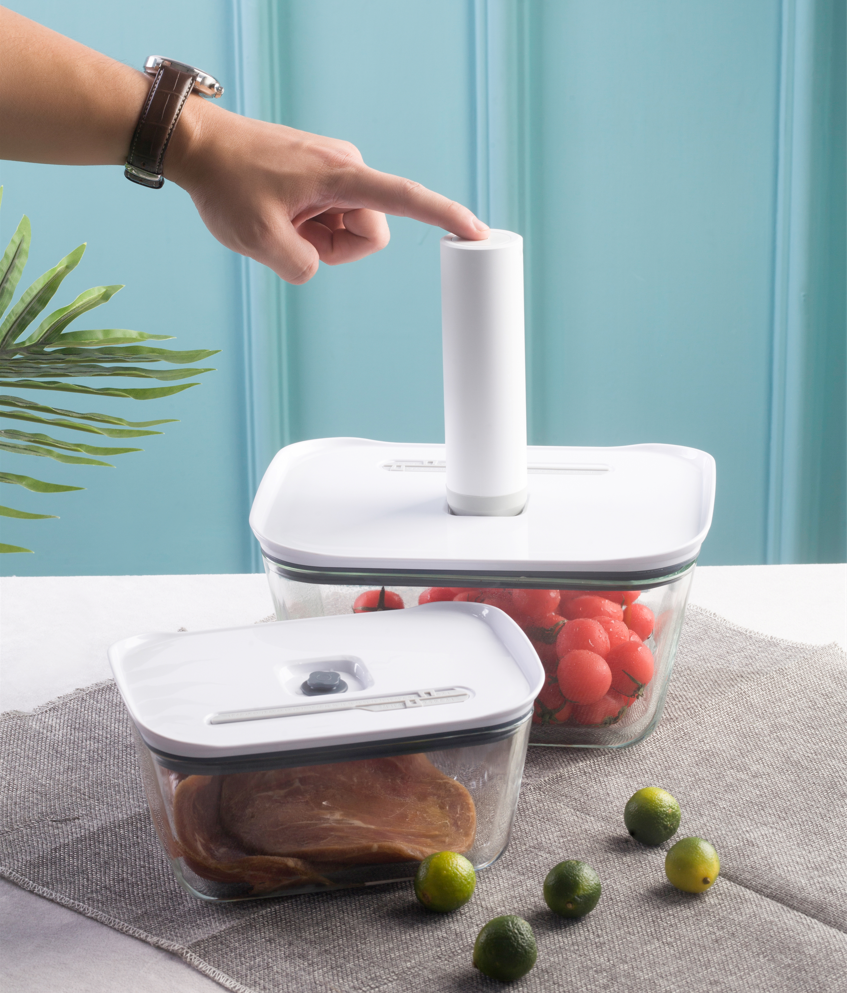Vacuum storage containers are a very effective way to preserve food, which can extend the shelf life of food, maintain the freshness and taste of food, and avoid food waste. This article will take an in-depth look at how long it takes to preserve food in a vacuum storage container and analyze the factors that influence it.

First, we need to understand what a vacuum storage container is. As the name suggests, a vacuum storage container is a storage tool that uses air extraction to extract the air inside the container to form a near-vacuum state, thereby reducing the contact between oxygen and food. This kind of container is usually made of pressure-resistant and well-sealed materials, such as glass or plastic, and is equipped with a special air pump.
Next, we are going to explore the principles of vacuum storage. An important cause of food spoilage is the growth and reproduction of microorganisms, which require oxygen and moisture to survive. Vacuum storage significantly reduces the activity of microorganisms by excluding oxygen, thereby delaying the spoilage process of food. In addition, under vacuum, the evaporation of water in the food is reduced, maintaining the freshness of the food.
So, how long can a vacuum storage container preserve food? This depends on a variety of factors. The first thing that bears the brunt is the variety of food. For example, dry foods such as rice and beans can be stored for a long time in a vacuum state because they have low water content and are not prone to bacterial growth; while perishable foods such as meat and fish can only be stored in a vacuum environment. Save for a limited time. In addition, the initial state of food will also affect the storage time. Fresh and uncontaminated food will naturally last longer.
Environmental factors cannot be ignored either. Temperature is one of the key factors that affects how long food is stored. At room temperature, even vacuum-preserved food will gradually deteriorate; while low-temperature storage in the refrigerator can greatly extend the shelf life of food. Humidity is also an important factor. Excessive humidity promotes the growth of microorganisms, so in humid environments, food may spoil faster, even when using vacuum storage containers.
Through practical case analysis, we can draw some best practices for using vacuum storage containers. For example, refrigerated cut fruits stored in vacuum containers can maintain their freshness for about a week; while unopened meat products can be kept fresh for several months or even more than half a year if frozen in a vacuum environment. For best results, it is recommended to check the status of your food regularly and follow the "first in, first out" principle.
In addition to the above factors, the quality of the vacuum storage container itself is also crucial. A well-sealed container can more effectively isolate outside air, while a well-designed container can be user-friendly and ensure that food is exposed to as little air as possible during storage. Therefore, choosing a high-quality vacuum storage container is crucial to extending the shelf life of your food.
Of course, vacuum storage is not a panacea and it has limitations. For example, some foods with high moisture content, such as fruits and vegetables, may evaporate under vacuum, causing the food to lose its crisp texture. In addition, vacuum storage cannot prevent the activity of enzymes in food, which means that some foods may spoil due to their own enzymes.
Choosing the right vacuum storage container is crucial. The container material should be food-safe and strong enough to resist external pressure. The size and shape of the container should be appropriate for the amount and type of food that needs to be stored. When using, make sure the inside of the container is clean and smell-free to avoid contaminating food. Operate your vacuum sealer correctly to ensure optimal vacuum conditions.
As an effective food preservation tool, vacuum storage containers can significantly extend the shelf life of food. However, achieving optimal preservation results requires a comprehensive consideration of multiple factors such as food type, container selection, and storage conditions. Through scientific methods and proper operations, we can not only reduce food waste, but also enjoy longer-term food safety and freshness. As vacuum storage technology continues to advance, we have reason to expect more efficient and smarter food storage solutions in the future.
Vacuum storage boxes allow food to be stored for longer
No takeaway, start with vacuum food storage containers
Use the vacuum food storage containers to keep bananas fresh
Fresh-keeping tool: Exploring the sealing secrets of vacuum storage containers
Vacuum storage container: a magic tool to extend food preservation time
Keeping fresh: How to properly clean and maintain vacuum storage containers
Vacuum storage container buying guide: how to choose the right storage tool for you
7 Essential Tips for Safe and Effective Use of Vacuum Storage Containers
In-depth discussion on the classification and application of vacuum storage containers
How to choose the size and capacity of a vacuum storage container?
How to clean and care for vacuum storage containers: effective methods and precautions
How to properly use vacuum storage containers to preserve food
Exploring the impact of vacuum storage container shape on food storage
Analyze the price of vacuum storage containers
Material selection for vacuum storage containers
Factors affecting storage time and effectiveness of vacuum storage containers
Selection and use of household vacuum storage containers
An in-depth analysis of the moisture-proof and anti-corrosion effects of vacuum storage containers
Vacuum storage container market development and prospect analysis
mia
ltt@bsfmould.com
